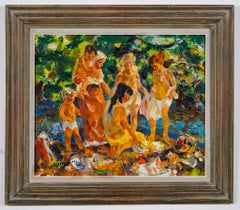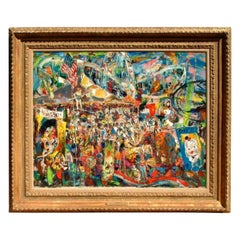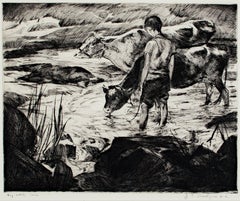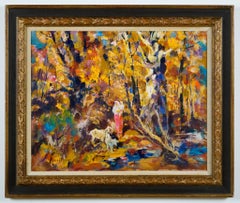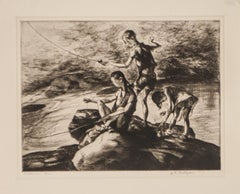John Edward Costigan Art
American, 1888-1972
An American Painter Compositional painter of figures and country animals; watercolor painter Costigan was a largely self-taught artist. He moved from Providence, Rhode Island to New York City as an orphaned teenager in 1904 to work for a commercial poster company. It was here that he learned the rudiments of drawing and painting, skills he furthered with informal study at New York's Kit Kat Club, a popular artists' hangout. Costigan achieved national fame as a painter and printmaker in the1920s and 30s. He won numerous prestigious awards and, despite his lack of formal artistic training, was elected a full member of the National Academy of Design. In 1937 the Smithsonian Institution held a one-person exhibition of his graphic works. Famed American printmaker John Taylor Arms praised Costigan as "a brilliant etcher, particularly noted for his interpretation of life on the American farmstead." Today prints by Costigan can be found in private and public collections around the nation, including the Prints and Photographs Division of the Library of Congress in Washington, which owns twenty-two. The Swope exhibition is the largest devoted to Costigan's work since the late 1960s. Many of the forty-five prints in the exhibition are from the Swope's own extensive holdings of Costigan's works. Other are being lent by private collectors from around the country.to
1
5
1
1
1
Overall Width
to
Overall Height
to
9
2
1
2
4
1
9
7
5
5
4
2
1
1
1
5
4
3
1
1
10
7,763
4,946
2,504
1,372
5
9
Artist: John Edward Costigan
Bathers
By John Edward Costigan
Located in Sheffield, MA
John Edward Costigan, N.A.
American, 1888-1972
Bathers
Oil on canvas
Signed ‘J.E. Costigan N.A.’ lower left
20 by 24 in. W/frame 26 by 30 in.
John Costigan was born of Irish-American parents in Providence, Rhode Island, February 29, 1888. He was a cousin of the noted American showman, George M. Cohan, whose parents brought the young Costigan to New York City and was instrumental in starting him on a career in the visual arts. They were less successful in encouraging him to pursue formal studies at the Art Students League (where, however, he later taught) than in exposing him to the commercial art world through the job they had gotten him with the New York lithographing firm that made their theatrical posters.
At the H. C. Miner Lithographing Company, Costigan worked his way up from his entry job as a pressroom helper, through various apprenticeships, to the position of sketch artist. In the latter capacity he was an uncredited designer of posters for the Ziegfeld Follies and for numerous silent films. Meanwhile, he had supplemented his very meager formal studies in the fine arts with a self-teaching discipline that led to his first professional recognition in 1920 with the receipt of prizes for an oil painting and watercolor in separate New York exhibitions.
A year earlier, Costigan had wed professional model Ida Blessin, with whom he established residence and began raising a family in the sleepy little rural New York hamlet of Orangeburg, the setting for the many idyllic farm landscapes and wood interiors with which he was to become identified in a career that would span half a century.
John Costigan’s first national recognition came in 1922 with his winning of the coveted Peterson Purchase prize of the Art Institute of Chicago for an oil on canvas, “Sheep at the Brook.” It marked the start of an unbroken winning streak that would gain him at least one important prize per year for the remainder of the decade. The nation’s art journalists and critics began to take notice, making him the recurring subject of newspaper features and magazine articles. The eminent author and critic Edgar Holger Cahill was just a fledgling reporter when he wrote his first feature, “John Costigan Carries the Flame,” for Shadowland Magazine in 1922. Costigan had his first one-man show of paintings at the Rehn Gallery on New York’s 5th Avenue in November, 1924, to be followed less than three years later by another at the Art Institute of Chicago. In addition, Costigan’s work has been—and continues to be included, side-by-side with that of some of America’s most high-profile artists, in museum and gallery exhibitions throughout the country. His renown had peaked in the early 1930s, by which time his work had been honored with nearly every major award then being bestowed in the fine arts and had been acquired for the permanent collections of several prestigious American museums, including New York’s Metropolitan (which only recently, in 1997, deaccessioned his “Wood Interior,” acquired in 1934).
Although Costigan’s celebrity had ebbed by the late 1930s, the Smithsonian Institution saw fit in 1937 to host an exhibition exclusively of his etchings. And, in 1941, the Corcoran Gallery (also Washington, D.C.) similarly honored him for his watercolors. (Another Washington institution, the Library of Congress, today includes 22 Costigan etchings and lithographs in its permanent print collection.)
During World War II, Costigan returned briefly to illustrating, mainly for Bluebook, a men’s pulp adventure magazine. A gradual revival of interest in his more serious work began at the end of the war, culminating in 1968 with the mounting of a 50-year Costigan retrospective at the Paine Art Center and Arboretum in Oshkosh, Wisconsin. Oils, watercolors and prints were borrowed from museums and private collections throughout the country, and the exhibition was subsequently toured nationally by the Smithsonian Institution.
John Costigan died of pneumonia in Nyack, NY, August 5, 1972, just months after receiving his final prestigious award —the Benjamin West Clinedinst Medal of the Artist’s Fellowship, Inc., presented in general recognition of his “...achievement of exceptional artistic merit...” in the various media he had mastered in the course of his career.
This painting depicts one of the artist's favorite themes --the farm family bathing...
Category
1950s Post-Impressionist John Edward Costigan Art
Materials
Oil
John Edward Costigan Painting, circa 1950's - Carnival
By John Edward Costigan
Located in Phoenix, AZ
John Costigan (1888-1972) oil on canvas, circa: 1950s. In excellent condition.
Exciting Expressionist Painting of a lively Carnival Scene. Signed lower right: ''J.E. Costigan",
Title...
Category
Mid-20th Century John Edward Costigan Art
Materials
Paint
20th century drypoint etching figurative animal print black and white signed
By John Edward Costigan
Located in Milwaukee, WI
"Boy With Cows" is an original drypoint etching by John Edward Costigan. It depicts a young boy with three cows standing in a watering hole. The artist si...
Category
1930s American Realist John Edward Costigan Art
Materials
Drypoint, Etching
Woman and Child
By John Edward Costigan
Located in Sheffield, MA
John Edward Costigan, N.A.
American, 1888-1972
Woman and Child
Oil on canvas
Signed ‘J.E. Costigan N.A.’ lower left
24 by 30 in. W/frame 32 by 38 in.
John Costigan was born of Irish-American parents in Providence, Rhode Island, February 29, 1888. He was a cousin of the noted American showman, George M. Cohan, whose parents brought the young Costigan to New York City and was instrumental in starting him on a career in the visual arts. They were less successful in encouraging him to pursue formal studies at the Art Students League (where, however, he later taught) than in exposing him to the commercial art world through the job they had gotten him with the New York lithographing firm that made their theatrical posters.
At the H. C. Miner Lithographing Company, Costigan worked his way up from his entry job as a pressroom helper, through various apprenticeships, to the position of sketch artist. In the latter capacity he was an uncredited designer of posters for the Ziegfeld Follies and for numerous silent films. Meanwhile, he had supplemented his very meager formal studies in the fine arts with a self-teaching discipline that led to his first professional recognition in 1920 with the receipt of prizes for an oil painting and watercolor in separate New York exhibitions.
A year earlier, Costigan had wed professional model Ida Blessin, with whom he established residence and began raising a family in the sleepy little rural New York hamlet of Orangeburg, the setting for the many idyllic farm landscapes and wood interiors with which he was to become identified in a career that would span half a century.
John Costigan’s first national recognition came in 1922 with his winning of the coveted Peterson Purchase prize of the Art Institute of Chicago for an oil on canvas, “Sheep at the Brook.” It marked the start of an unbroken winning streak that would gain him at least one important prize per year for the remainder of the decade. The nation’s art journalists and critics began to take notice, making him the recurring subject of newspaper features and magazine articles. The eminent author and critic Edgar Holger Cahill was just a fledgling reporter when he wrote his first feature, “John Costigan Carries the Flame,” for Shadowland Magazine in 1922. Costigan had his first one-man show of paintings at the Rehn Gallery on New York’s 5th Avenue in November, 1924, to be followed less than three years later by another at the Art Institute of Chicago. In addition, Costigan’s work has been—and continues to be included, side-by-side with that of some of America’s most high-profile artists, in museum and gallery exhibitions throughout the country. His renown had peaked in the early 1930s, by which time his work had been honored with nearly every major award then being bestowed in the fine arts and had been acquired for the permanent collections of several prestigious American museums, including New York’s Metropolitan (which only recently, in 1997, deaccessioned his “Wood Interior,” acquired in 1934).
Although Costigan’s celebrity had ebbed by the late 1930s, the Smithsonian Institution saw fit in 1937 to host an exhibition exclusively of his etchings. And, in 1941, the Corcoran Gallery (also Washington, D.C.) similarly honored him for his watercolors. (Another Washington institution, the Library of Congress, today includes 22 Costigan etchings and lithographs in its permanent print collection.)
During World War II, Costigan returned briefly to illustrating, mainly for Bluebook, a men’s pulp adventure magazine. A gradual revival of interest in his more serious work began at the end of the war, culminating in 1968 with the mounting of a 50-year Costigan retrospective at the Paine Art Center and Arboretum in Oshkosh, Wisconsin. Oils, watercolors and prints were borrowed from museums and private collections throughout the country, and the exhibition was subsequently toured nationally by the Smithsonian Institution.
John Costigan died of pneumonia in Nyack, NY, August 5, 1972, just months after receiving his final prestigious award —the Benjamin West Clinedinst Medal of the Artist’s Fellowship, Inc., presented in general recognition of his “...achievement of exceptional artistic merit...” in the various media he had mastered in the course of his career.
This painting depicts one of the artist's favorite themes --the farm family bathing...
Category
1940s Post-Impressionist John Edward Costigan Art
Materials
Oil
Fisherman Three 1939 original signed etching by John E. Costigan
By John Edward Costigan
Located in Paonia, CO
Fisherman Three is an original 1939 signed etching by the American artist John E. Costigan
( 1888-1972 ) a self-taught painter and printmaker. The locale for Costigan...
Category
Mid-20th Century Other Art Style John Edward Costigan Art
Materials
Etching
Group of Workers
By John Edward Costigan
Located in San Francisco, CA
This artwork titled "Group of Workers" 1943, is an original lithograph on paper by noted American artist John Edward Costigan, 1888-1972. It is hand signed and titled in pencil by th...
Category
Mid-20th Century Realist John Edward Costigan Art
Materials
Lithograph
Bathing Group
By John Edward Costigan
Located in Sheffield, MA
John Edward Costigan
American, 1888-1972
Bathing Group
Oil on canvas board
12 by 16 in, w/ frame 19 by 23 in
Signed ‘J.E. Costigan N.A.’ lower left
John Costigan was born of Irish-...
Category
Mid-20th Century Modern John Edward Costigan Art
Materials
Oil
"When Day is Done, " an Original Etching signed by John Edward Costigan
By John Edward Costigan
Located in Milwaukee, WI
"When Day is Done" is an original etching and aquatint signed lower right in pencil by the artist John Edward Costigan. It depicts a man and a woman with their young child at the end...
Category
1930s Post-Impressionist John Edward Costigan Art
Materials
Etching, Aquatint
Bathing Group
By John Edward Costigan
Located in Sheffield, MA
John Edward Costigan, N.A.
American, 1888-1972
Bathing Group
Oil on canvas board
Signed ‘J.E. Costigan N.A.’ lower left
12 by 16 in. W/frame 20 by 24 i...
Category
1950s Post-Impressionist John Edward Costigan Art
Materials
Oil
Related Items
Notre-Dame de Paris, Oil on Canvas by Henri André Martin
Located in Saint Amans des cots, FR
Oil on canvas by Henri-André Martin (1918-2004), France, ca.1960. Notre-Dame de Paris. With frame: 79.3x 60.3 cm - 31.2x23.7 inches. Without frame: 54x 73 cm - 21.3x28.7 inches. 20P ...
Category
1960s Post-Impressionist John Edward Costigan Art
Materials
Canvas, Oil
H 23.75 in W 31.23 in D 1.97 in
Echoes of the Avant-Garde: Mid-Century Visions III (circa 1970s)
Located in London, GB
'Echoes of the Avant-Garde: Mid-Century Visions III', oil on board (circa 1970s). Step into a world where the spirit of early 20th-century modernism meets the bold experimentation o...
Category
1970s Abstract John Edward Costigan Art
Materials
Oil, Board
"Budapest Street Scene" 20th Cen. Hungarian Impressionist Oil Painting on Canvas
Located in New York, NY
A beautiful oil on canvas painting by Hungarian artist, Hugo Matzenauer. Matzenauer was a painter known for his colorful cityscapes depicting the times...
Category
20th Century Post-Impressionist John Edward Costigan Art
Materials
Canvas, Oil
"Prickly Pete" Contemporary Abstract Colorful Western Cowboy Portrait Painting
Located in Houston, TX
Colorful abstract cowboy portrait painting by contemporary artist Ian Francis. The work features a western inspired figure with a shadowed face dressed...
Category
2010s Contemporary John Edward Costigan Art
Materials
Canvas, Acrylic
Dancers
Located in San Francisco, CA
This artwork titled "Dancers" c.1990is a color offset lithograph by noted equine American artist Fred Stone, 1930-2018. It is hand signed in pencil by the a...
Category
Late 20th Century American Realist John Edward Costigan Art
Materials
Lithograph
Landscape with Bridge - Etching by J. C. Richard de Saint-Non - 18th Century
Located in Roma, IT
Landscape with Bridge is a beautiful black and white etching realized by Jean-Claude Richard de Saint-Non at the end of 18th Century.
On lower margin under the image the inscriptio...
Category
Late 18th Century Old Masters John Edward Costigan Art
Materials
Etching
La Cote de Marseille - Post Impressionist Sea Landscape Oil by Louis Gaussen
By Adolphe Louis Gaussen
Located in Marlow, Buckinghamshire
Signed seascape oil on panel circa 1910 by French painter post impressionist painter Adolphe Louis Gaussen. The work depicts a view of the bright blue sea from a rocky shoreline on t...
Category
1910s Post-Impressionist John Edward Costigan Art
Materials
Oil, Panel
RIOT POLICE Hand Pulled Lithograph, Black White Drawing, Law Enforcement, Police
Located in Union City, NJ
RIOT POLICE - artist unknown
Print Size - 23" x 30", full bleed image, no margins, unframed, unsigned proof, excellent condition
Year - c. 1973
RIOT POLICE is an original hand draw...
Category
1970s Realist John Edward Costigan Art
Materials
Lithograph
The Butterfly.
By Edmund Blampied
Located in Storrs, CT
Edmund Blampied, R.E. The Butterfly. 1928-29. Drypoint. Appleby 133. 9 5/8 x 7 7/8). Etching (sheet 15 1/4 x 10 3/16)on 100. A rich impression printed on cream-colored laid 'F.J.He...
Category
Early 20th Century Modern John Edward Costigan Art
Materials
Drypoint, Etching
Southern City by the sea atmospheric large blue green seascape harbour painting
Located in Norwich, GB
A very atmospheric and idyllic view of a Southern fishing port, painted most likely in Italy or France. Resolutely post-impressionist, the landscape is imbued with the light of the M...
Category
Early 20th Century Post-Impressionist John Edward Costigan Art
Materials
Canvas, Oil, Fiberboard
H 29.14 in W 33.86 in D 2.76 in
Art Forms in Nature (Plate 79 - Basiliscus) — 1899 Celebration of Nature
Located in Myrtle Beach, SC
Ernst Haeckel, 'Art Forms in Nature' (Plate 79 - Basiliscus), offset lithograph, 1899. Signed and titled in typeset, upper left. Titled 'Tafel 79 — Basi...
Category
1890s Realist John Edward Costigan Art
Materials
Lithograph
'Abstract in Coral and Jade', Painters Eleven, Ontario, Canadian Modernist Oil
By Hortense Mattice Gordon
Located in Santa Cruz, CA
Signed lower left, 'Hortense M. Gordon' for Hortense Crompton Mattice Gordon (Canadian, 1886-1961) and dated 1949.
Previously with: Dominion Gallery of Montreal (stamp, verso).
Photo courtesy of Art Gallery of Hamilton, Ontario, Canada.
Hamilton artist Hortense Crompton Mattice Gordon was one of Canada’s earliest non-representational painters, embracing abstraction in the 1930s. She was also an active member of Canada's first English-speaking abstract group, Painters Eleven.
A scholarship recipient, Hortense Mattice first attended the Hamilton Art School and, subsequently, moved to Chatham, Ontario. Initially focusing on porcelain painting, Mattice quickly began building a portfolio of oils and, from 1908, was exhibiting both her porcelain and landscapes at what is now the Chatham Cultural Centre (1908) and the Art Gallery of Ontario (1909). During this time, Mattice frequently traveled to the United States and, in 1915, visited the National Gallery of Art in Washington, DC, where she would have seen early works by important modernists including Picasso and Matisse. She started her teaching career in Chatham but, having received a job offer from the artist John Sloan Gordon, returned to Hamilton to teach at the Hamilton Art School in 1918. The two artists married in 1920.
In 1922, Gordon and her husband took a study trip to France and, inspired by the fervent of Modernist ideas in Paris, expanded her own approaches to art, developing an increasingly soft, loose paint handling style. It was not until the 1930’s, after a few more trips to France and her discovery of Piet Mondrian’s work, that elements of abstraction began to appear in Gordon’s work. After the death of her husband in 1940, Gordon attended the Cranbrook Academy of Art and studied with Hans Hoffmann (1941-1945) whose influence and friendship pushed her to explore non-objective painting. After her training with Hofmann and in Cranbrook, Gordon began to exhibit regularly and with success in both Canada and the United States including at the Riverside Museum (New York, 1947), Creative Gallery (New York, 1952), in Ann Arbor (Michigan, 1952), Phillips Gallery (Detroit, 1952), the Flint Institute of Arts (Michigan, 1952), Mount Allison University (New Brunswick, 1952), the Galerie Agnes Lefort in Montréal and Art Gallery of Hamilton (retrospective, 1960). She was a member of the Contemporary Artists of Hamilton (honorary president in 1948), the Ontario Society of Artists, the Hamilton Women...
Category
1940s Abstract John Edward Costigan Art
Materials
Oil, Board
Previously Available Items
Cutting Foddor original 1938 etching by John Costigan
By John Edward Costigan
Located in Paonia, CO
Cutting Fodder, also known as Family in the Field, is an original signed 1938 etching by the American artist John E. Costigan ( 1888-1972 )a self-taught painter and printmaker. ...
Category
Mid-20th Century Other Art Style John Edward Costigan Art
Materials
Etching
H 11.25 in W 15.75 in
John Edward Costigan art for sale on 1stDibs.
Find a wide variety of authentic John Edward Costigan art available for sale on 1stDibs. You can also browse by medium to find art by John Edward Costigan in etching, oil paint, paint and more. Much of the original work by this artist or collective was created during the 20th century and is mostly associated with the Post-Impressionist style. Not every interior allows for large John Edward Costigan art, so small editions measuring 15 inches across are available. Customers who are interested in this artist might also find the work of Charles Picart le Doux, Henri Riviere, and Edwin Georgi. John Edward Costigan art prices can differ depending upon medium, time period and other attributes. On 1stDibs, the price for these items starts at $600 and tops out at $9,850, while the average work can sell for $2,100.
